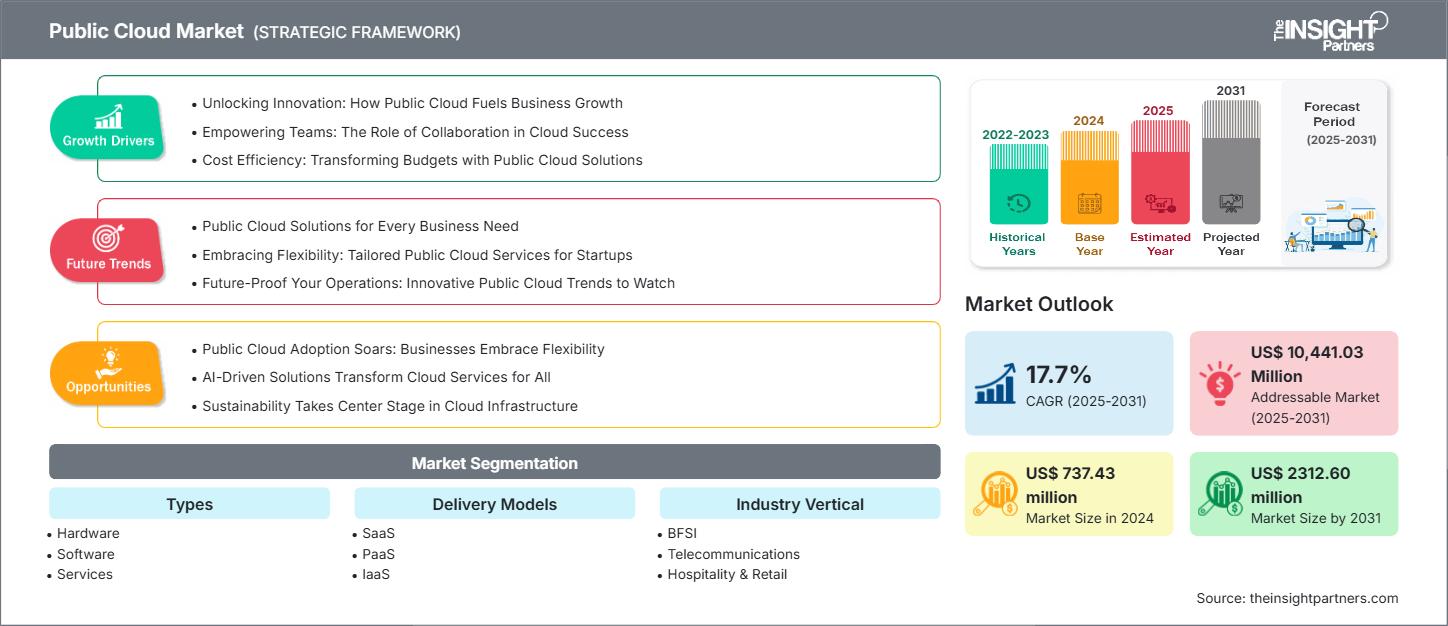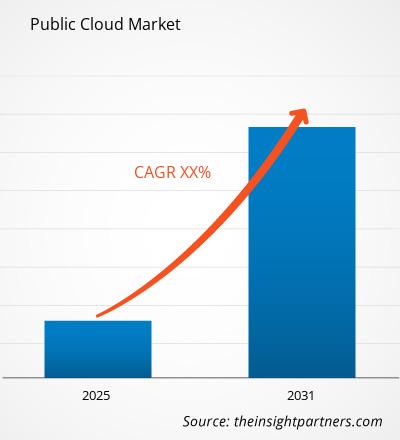Si prevede che il mercato del cloud pubblico raggiungerà i 684,47 miliardi di dollari entro il 2031. Si stima che il mercato registrerà un CAGR del 14,8% nel periodo 2025-2031.
I servizi cloud fungono da storage o da fornitori terzi in cui i dati dell'organizzazione vengono archiviati per vari scopi. I dati archiviati vengono poi recuperati per scopi analitici. Il dominio del cloud pubblico indica i servizi cloud offerti su una rete pubblica accessibile da remoto. Il principale vantaggio del modello di cloud pubblico è che le organizzazioni avranno limitate preoccupazioni in merito all'archiviazione e alla manutenzione dei dati. La configurazione è off-premise e l'architettura è di tipo multi-tenant, in cui diverse organizzazioni condividono lo spazio di elaborazione del fornitore terzo. Le PMI trarranno maggiori vantaggi esternalizzando l'archiviazione e la manutenzione dei propri dati a fornitori cloud terzi, risparmiando così notevolmente sugli investimenti di capitale per la configurazione dell'infrastruttura. Il risparmio sui costi, la rapidità di sviluppo e test e il time-to-market ridotto hanno spinto molte aziende di vari settori verticali ad adottare la tecnologia del cloud pubblico.
Otterrai la personalizzazione gratuita di qualsiasi report, incluse parti di questo report, analisi a livello nazionale, pacchetto dati Excel e potrai usufruire di fantastiche offerte e sconti per start-up e università.
Mercato del cloud pubblico: approfondimenti strategici

- Scopri le principali tendenze di mercato di questo rapporto.Questo campione GRATUITO includerà analisi dei dati, che spaziano dalle tendenze di mercato alle stime e alle previsioni.
Nell'ultimo decennio, il settore del software ha assistito a enormi cambiamenti. L'implementazione di modelli cloud da parte delle organizzazioni è stata la più importante, grazie ai vantaggi che offrono. L'elevata scalabilità delle aziende le spinge a optare per servizi basati su cloud, poiché i dati nei centri di archiviazione possono essere scalati verso l'alto o verso il basso in base alle esigenze degli utenti. Inoltre, la struttura tariffaria adottata dai fornitori di cloud pubblico è generalmente basata sul modello pay-as-per-use. Le organizzazioni, in particolare le PMI, non devono pagare cifre esorbitanti in un'unica soluzione, il che rende altamente auspicabile per loro implementare modelli di cloud pubblico per le proprie attività aziendali. Le competenze chiave delle aziende vengono preservate, consentendo loro di rimanere competitive in questo mercato altamente dinamico. La riduzione dei costi operativi e la vasta gamma di soluzioni specifiche per ogni azienda offerte da un'unica fonte sono i principali driver del mercato dei servizi di cloud pubblico. Anche la necessità di un'infrastruttura IT scalabile, flessibile, semplice ed efficiente sta trainando notevolmente questo mercato. Gli errori umani sono ridotti al minimo poiché le operazioni sono gestite interamente dalle macchine, il che spinge le organizzazioni ad adottare i servizi di cloud pubblico. I fattori sopra menzionati sono alla base dell'adozione esponenziale di questo mercato. Nonostante la sua significativa adozione nei paesi sviluppati, la crescita dei servizi di cloud pubblico ha incontrato pochi vincoli. Le preoccupazioni relative alla sicurezza e alla riservatezza dei dati sono state il principale fattore limitante per questo mercato. I requisiti di connettività Internet per questo modello cloud sono elevati e nei paesi con scarsa connettività avranno un impatto sull'implementazione del cloud pubblico. Anche l'integrazione del modello con i sistemi legacy ha rappresentato un fattore limitante. Altri vincoli per questo mercato includono le interruzioni e la mobilità dei dati.
Approfondimenti regionali sul mercato del cloud pubblico
Le tendenze e i fattori regionali che hanno influenzato il mercato del cloud pubblico durante il periodo di previsione sono stati ampiamente spiegati dagli analisti di The Insight Partners. Questa sezione analizza anche i segmenti e la distribuzione geografica del mercato del cloud pubblico in Nord America, Europa, Asia-Pacifico, Medio Oriente e Africa, America meridionale e centrale.
Ambito del rapporto sul mercato del cloud pubblico
| Attributo del report | Dettagli |
|---|---|
| Dimensioni del mercato nel 2024 | XX miliardi di dollari USA |
| Dimensioni del mercato entro il 2031 | 684,47 miliardi di dollari USA |
| CAGR globale (2025 - 2031)CAGR (2025 - 2031) | 14,8% |
| Dati storici | 2021-2023 |
| Periodo di previsione | 2025-2031 |
| Segmenti coperti | Per tipi
|
| Regioni e paesi coperti | America del Nord
|
| Leader di mercato e profili aziendali chiave |
|
Densità degli attori del mercato del cloud pubblico: comprendere il suo impatto sulle dinamiche aziendali
Il mercato del cloud pubblico è in rapida crescita, trainato dalla crescente domanda degli utenti finali, dovuta a fattori quali l'evoluzione delle preferenze dei consumatori, i progressi tecnologici e una maggiore consapevolezza dei vantaggi del prodotto. Con l'aumento della domanda, le aziende stanno ampliando la propria offerta, innovando per soddisfare le esigenze dei consumatori e sfruttando le tendenze emergenti, alimentando ulteriormente la crescita del mercato.

- Ottieni una panoramica dei principali attori del mercato del cloud pubblico
Il mercato globale del cloud pubblico è stato segmentato per tipologia in hardware, software e servizi. Inoltre, il mercato del cloud pubblico è stato frammentato in base al modello di distribuzione in SaaS, PaaS e IaaS. Inoltre, questo mercato è stato ulteriormente segmentato in base agli utenti finali, ovvero PMI e grandi imprese. La segmentazione del mercato del cloud pubblico viene effettuata anche in base ai settori verticali, tra cui BFSI, telecomunicazioni, ospitalità e vendita al dettaglio, pubblica amministrazione, produzione e assistenza sanitaria. Il Nord America è leader del mercato globale del cloud pubblico grazie ai notevoli progressi tecnologici e allo sviluppo socioeconomico della regione. L'Europa, un altro importante polo industriale, ha contribuito alla crescita del mercato del cloud pubblico. La regione nordica in Europa, con molte piccole industrie, ha contribuito in modo significativo alla quota di mercato europea del cloud pubblico. Inoltre, la regione APAC sta recuperando terreno rispetto a queste regioni, con paesi in via di sviluppo come India e Cina che investono gradualmente nelle tecnologie del cloud pubblico. Tra i principali attori che operano nel mercato globale del cloud pubblico figurano, tra gli altri, Microsoft Corporation, Salesforce.com, Cisco Systems, Inc., VMWare, Google, Inc., Oracle Corporation ed Eucalyptus.
- Analisi storica (2 anni), anno base, previsione (7 anni) con CAGR
- Analisi PEST e SWOT
- Valore/volume delle dimensioni del mercato - Globale, Regionale, Nazionale
- Industria e panorama competitivo
- Set di dati Excel
Report recenti
Testimonianze
Motivo dell'acquisto
- Processo decisionale informato
- Comprensione delle dinamiche di mercato
- Analisi competitiva
- Analisi dei clienti
- Previsioni di mercato
- Mitigazione del rischio
- Pianificazione strategica
- Giustificazione degli investimenti
- Identificazione dei mercati emergenti
- Miglioramento delle strategie di marketing
- Aumento dell'efficienza operativa
- Allineamento alle tendenze normative




















 Ottieni un campione gratuito per - Mercato del cloud pubblico
Ottieni un campione gratuito per - Mercato del cloud pubblico